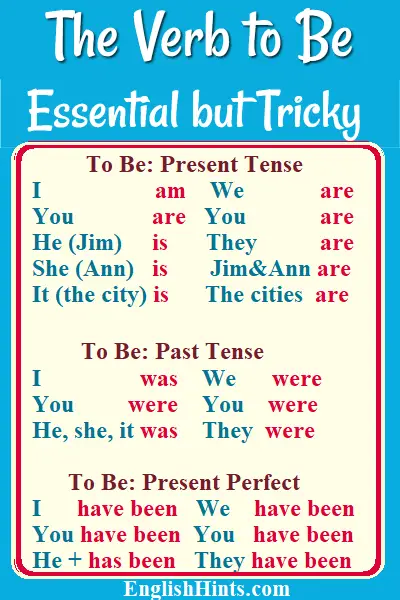The Verb to Be: Essential-- But Tricky
If you know how to use the verb to be, you can get by in English with only a few more verbs. Without it, you really can’t speak English at all!
It isn’t too difficult to learn (though most other verbs are easier.) You just need to learn a few forms well. It’s worth it! We use it far more than any other verb.
‘To Be’ in the Present Tense
The present tense of ‘be’ has three forms. We say "I am," "he (or she, or it) is," and "you (or we or they) are."
All other English verbs have only two forms in the simple present tense. (That's 3rd-person singular for he, she, or it, and the base form for everything else.)
No other English verb has a form like ‘am,’ for speaking about oneself. (“I am an ESL teacher." “I am teaching English online now.”)
We use ‘is’ for third person singular-- to talk about one person or thing.
“Larry is a student. He’s studying engineering. So is his girlfriend. His dog is disappointed because Larry is too busy to play with him much.”
We use ‘are’ for you (singular or plural) and all other plurals. “Are you studying English or engineering? My friends are studying both, so they are busy all day! We are lonely! The phone lines are quiet because our friends aren’t calling us anymore.”
Contractions of ‘to Be’ in the Present
I am= I’m; I am not= I’m not. (there’s no contraction for am + not.)
You are= you’re; you are not= you’re not OR you aren’t.
He is= he’s; he is not= he’s not OR he isn’t (the same for she or it: it isn’t; she’s not, or the reverse.)
We are= we’re; we are not= we’re not OR we aren’t.
They are= they’re; they are not= they’re not or they aren’t.
Examples:
· “What time is it?” “It’s 2:30.” (pronounced ‘two-thirty’ or ‘half past two.’)
· “I’m over 50, but my daughter isn’t 30 years old yet. She’s still young!”
· “Why are you still here waiting?”
· “Because my friends aren’t ready to go yet.”
The Present Continuous (or Progressive) Tense
‘To be’ is the helping verb for the continuous tenses. It is used with the -ing form (the present participle-- same form as the gerund) of another verb:
· I’m going to the store now.
· Are you listening?
· Jim isn’t studying; he’s thinking about his girlfriend.
· They’re celebrating their one month anniversary.
(You can even use ‘be’ again as the main verb. Children often complain to their parents-- ‘he’s being mean!’)
The past continuous tense works like the present continuous, except it uses past forms of be. (See examples under Past Tense.) It is most often used to talk about something that happened over a period of time. It's used especially in contrast to another event that happened suddenly.
The Verb to Be Used with Helping Verbs
‘To be’ is the only verb we don’t use with ‘do’ in questions and negatives. ‘Be’ can stand alone. It does combine with ‘have’-- see the Perfect Tenses section below. Use the base form (be) with modals like can, could, should, would, may, might, or will (below):
· You can be anything you want to be.
· Could you be quieter, please? The baby’s sleeping.
· I would like (usually: I’d like) to be a grandmother someday.
· That bully should be ashamed of himself. Can’t he be nicer to little kids?
· Dad, may I please be excused?
· He might be interested in your offer; I don’t really know.
The Future: Will & Be Going to (Both are used.)
Are your parents going to visit you this year? I will definitely be anxious to see them.
· They’ll be coming to see us next month, but they won’t be with us for very long.
· We’ll be saying good-bye less than a week after they arrive since they’re going to visit my sister’s family too.
Past Tense of ‘To Be’
‘Be’ is the only English verb conjugated in the past tense. It has two forms: ‘was’ for 1st and 3rd person singular, and ‘were’ for 2nd person (you) and plurals. Its past participle is ‘been.’ So we say:
I was returning home when there was an earthquake near here.
What were you doing when the earthquake hit?
Weren’t you scared? I was, and my dog was so scared she whined for half an hour!
Our daughter was a student in 2006.
We were hoping to visit you, but it wasn’t possible.
Dan and Debbie were tired after their trip. Although they had been sleeping well, they were glad they had the weekend to rest some more.
The Verb to Be in the Perfect Tenses
We form the perfect tense using ‘have’ as the helping verb. Then we use the past participle of the main verb (That's ‘been’ for the verb ‘to be.’) So we can say
· “How have you been lately? It has been so long since we talked!” However, we usually would say (though we wouldn't write) “How've you been? It’s been so long since we talked!” In this case “it’s” is a contraction for ‘it has,’ not ‘it is.’
· “How long have you been working for IBM?”
· “I’ve been with them for over four years. It will have been five in January.”
· “I had been thinking of changing, but they have been very good to me.”
Notice how often you hear or read some form of the verb ‘to be.’ I would guess you can’t go more than a minute or two without finding it at least twice!
Home> English Verb Tenses> The Verb to Be.
Didn't find what you
needed? Explain what you want in the search box below.
(For example, cognates, past tense practice, or 'get along with.') Click to see the related pages on EnglishHints.
| site search by freefind | advanced |






